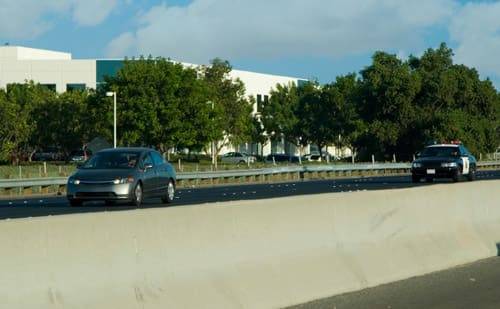Car-Chase Lingo Defined

In certain parts of the country, police pursuits occur with such frequency and are so popular with viewers that newscasters have to memorize entire dictionaries of car-chase vocabulary to keep the viewer up to speed.
In the interest of broadening our horizons, we’ve compiled a quick guide to the car-chase lingo, and it’s loosely structured in the order of how a pursuit might escalate. Some of these terms will be familiar, but others may require a deeper dive into the lexicon of police pursuit and defensive driving maneuvers. (Warning: Do not try these at home or — unless it’s the zombie apocalypse — ever).

Trailing: A self-evident term that simply describes a police vehicle signaling to the offending vehicle’s driver that he or she has messed up. Lights and sirens are deployed, dispatch alerted and a safe distance maintainted.
Pursuit position: This descrived the one-half vehicle width a police cruiser will put between it and the other vehicle (the position can be on either side of the offending vehicle). It allows the officer to see oncoming traffice, make the cruiser’s warning lights visible to that traffic and potentially force the other car to turn in a preferred direction. If the officer wants a better look inside the car he may move to a “reduced interval,” though this is more dangerous.
Controlled deflation device: Sometimes known as “spike strips,” these blow out the offending car’s tires and act as a low-risk road bloack. However, you never know what a driver on the lam might pull …
Moonshiner’s turn: Also known as a “J-turn,” this move is optimally undertaken with a manual transmission and leads to an abrupt 180-degree switch of the car’s direction. After encountering an obstacle and beginning to reverse, the driver whips the wheel hard to the left while simultaneously jamming on the emergency brake. Once the car has turned all the way around, the driver puts the car in 2nd gear and accelerates.
Bootlegger’s turn: Similar to the moonshiner’s turn, the bootlegger’s turn sends the car into a controlled skid. After accelerating to about 40 mph, the driver hits the handbrake, which begins the skid, and then whips the wheel to the left and accelerates out of the skid. All of this occurs in the width of two highway lanes and will wreak havoc on the suspension, tires and steering gears. Both maneuvers are the stuff of Prohibition-era legend when stock-car racer and moonshine runner Junior Johnson supposedly invented them while evading police or tax revenue agents intent on capturing bootleggers. Today we honor Johnson’s memory by using the term for folks who just ripped off a Circle K.
Stationary roadblock: This is a standard barricade of one or more police vehicles. It represents a serious escalation in attempting to stop the offending driver because for every roadblock, there is the counter to the roadblock.
Escaping the kill zone: When faced with no escape route and having encountered a blockade — usually two vehicles positioned across the roadway — a driver may attempt this manuever, which is essentially just ramming through the obstacle. Advanced Driving and Security Inc. recommends shifting the car to the lowest gear and holding the lever in place so it doesn’t pop out. Aiming the frame of the car into the axle of the barricade vehicle will give a driver the best chance of success since all you want to do is scoot the barricade vehicle’s tires aside, not wreck your own vehicle. This is what is know in the business as a “last resort.”
Rolling roadblock: Now things are serious. The police attempt to put one or two vehicles in front of or around the violator’s vehicle, and then they carefully slow down in an effort to get the driver to stop. If two or more cruisers move in front and alongside the vehicle to form a box, this is called “boxing in,” a more extreme variation of the rolling roadblock.
PIT maneuver: The Precision Immobilization Technique is a form of controlled contact where at low speeds a police vehicle will tap the rear of the violator’s vehicle just hard enough to send it spinning out of control. This is considered as serious as a police officer drawing his or her gun in terms of using deadly force. Training is highly recommended.
Uncontrolled contact: In this case, all else has failed and the officer has resorted to basically ramming the other vehicle and hoping for the best. Because of the unpredictable nature of this maneuver, officers are discouraged from using it except in extreme circumstances.
Featured stories




